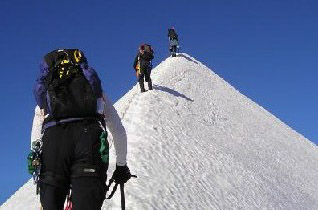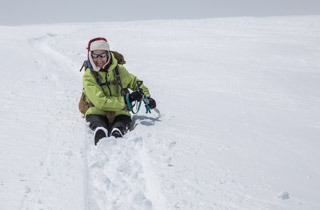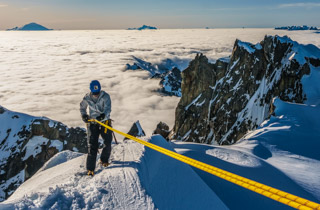Summit Day Preparation
Summit Day Preparation
Physical and Mental Preparation for Your Summit
Physical conditioning is an important component that goes into preparing for a high-altitude ascent. But don’t forget psychological readiness. Below we review a typical summit day and discuss what to do in advance to prepare for your climb, both physically and mentally.
Physical Conditioning
Most multi-day expeditions or high-altitude climbs require several months of solid physical conditioning leading up to them; the higher and/or longer the climb, the more involved the training. Consider a 2-day climb of a 14,400-foot peak such as Mt. Rainier, which usually involves ascending 4-5,000 feet of elevation with a heavy pack (anywhere from 35-55 pounds) on Day 1 and then going the rest of the way to the summit (4-5,000 feet) on Day 2 with a day pack, then returning to base camp to retrieve gear, and descending the remainder of the distance to the trailhead.


General Conditioning Program Requirements
The conditioning components you need to succeed include:
- regular spinal-loading cardiovascular training specific to high-altitude climbing,
- appropriate periodized strength training specific to your body’s needs several times a week targeting mountaineering-specific muscle groups;
- adequate daily flexibility training to ensure a normal range of motion in all joints;
- gradually increase pack weight on hikes until you can carry 5-10% more than your Target Pack Weight (TPW) several weeks before your climb;
- at least 1-2 Back-to-Back Pack Carrying outings leading up to your trip
Check, double-check, triple-check.
The Long Day
To get ready for the rigors of summit day, whether that is a trip to Everest, Denali, or Mt. Rainier, it would be highly beneficial to have one of your conditioning outings be a Long Day or an all-day trip with a loaded pack. You might be thinking, “Man, on top of everything else you listed? What about WORK and A FAMILY?” You can skip…. But it can mean the difference between enjoying your climb and suffering through it.
Consider a typical summit day climb of a high-altitude Cascade volcano such as Mt. Rainier in Washington.
- Reach base camp on Day 1 early afternoon, prepare camp, melt water, eat
- Grab whatever rest you can between 6 p.m. and midnight
- Get up at midnight or 1 a.m. Day 2 to get ready (cold, dark, unfamiliar)
- Start walking by 1 or 2 a.m. via headlamp and moonlight, if you are lucky
- If you are fast and lucky with great weather and a coordinated team, summit between 7-9 a.m.; if not, 12 hours after starting from base camp around noon
- Return to base camp (descending 4-5,000’) in 3-5 more hours
- Have a snack, refill water bottles, tear down camp and pack up
- Descend another 3-5,000’ to the trailhead in 3-5 hours. Total round trip time on Day 2 can be upwards of 18 hours for larger or slower parties.
If you have not had any day hikes of at least 10-12 hours, you will have no idea how your body will perform over such a long stretch of activity. While the Back-to-Back is crucial for experiencing what repeat days will feel like without recovery time, the Long Day will be invaluable in preparing your feet, shoulders, patience, and mental faculties for the extreme endurance needed to succeed on summit day.
Psychological Components
Succeeding at high-altitude climbing is a matter of dealing with unknowns. If you are going with a guided group, you may not know any of your climbing party until gear check at the trailhead. You also cannot control the weather. While you can plan a trip during “optimal months” or “high season” for your given objective, snow levels vary from year to year, and you cannot control climatic factors such as El Nino or La Nina or recent storms.
However, there are some things you can control ahead of time that can make you feel more comfortable on summit day:
- Hydrate and fuel often – set a watch alarm on your hikes to get into the habit of drinking every 30-45 minutes and having a light snack as you hike; keep drink and food handy so you do not have to stop and remove your backpack when the urge to nibble strikes.
- Gear Familiarity – for alpine starts you will be putting on crampons in the dark, tying knots by headlamp with cold fingers, starting a flame stove in the wind, and doing tasks on fitful sleep. Be as familiar with all of your equipment and gear as possible so that simple tasks do not use precious energy or brainpower. Save it for the climb.
- Mantra – Have some sort of saying or tune you turn to when you start to feel overwhelmed, whether that is “Inch by inch, it’s a cinch” or an upbeat song that inspires you to keep moving.
- Train like you will climb — Listening to headphones on a climb is a bad idea. You want to be aware of your teammates and surroundings at all times. If you always listen to music or podcasts while hiking, do several hikes without your headphones so that you don’t become reliant on “entertainment” to handle the long hours. Likewise. If you always use two poles, train with one several times so you will be comfortable having one ice axe in your hand.
- Turn-around time –Have, know, and stick to your group’s turn-around time on summit day. Having a set time can be a huge motivator that you WILL be able to rest and turn around at some point. This can help with pacing, and it is how guides gauge your progress; if you struggle to gain 500 feet per hour out of camp, they know you will be unable to reach the summit before snow conditions deteriorate.
- Study the route – Know what is expected of you and what the route will be like in terms of terrain, plans for rest breaks, and tricky navigation or technical areas. By understanding what you will face, you remove some “unknowns” that can be stressful. Study previous trip reports, talk with guides, other climbers who have done the route before, rangers at camp, or even descending climbers.
- Know how to handle your fears.
Ultimately, you can be in peak physical condition and have great weather for your climb, but if you fumble with your equipment, get spooked by exposure, or forget to eat and drink regularly, you still run the risk of not reaching your objective. These are all things you can manage ahead of time.





